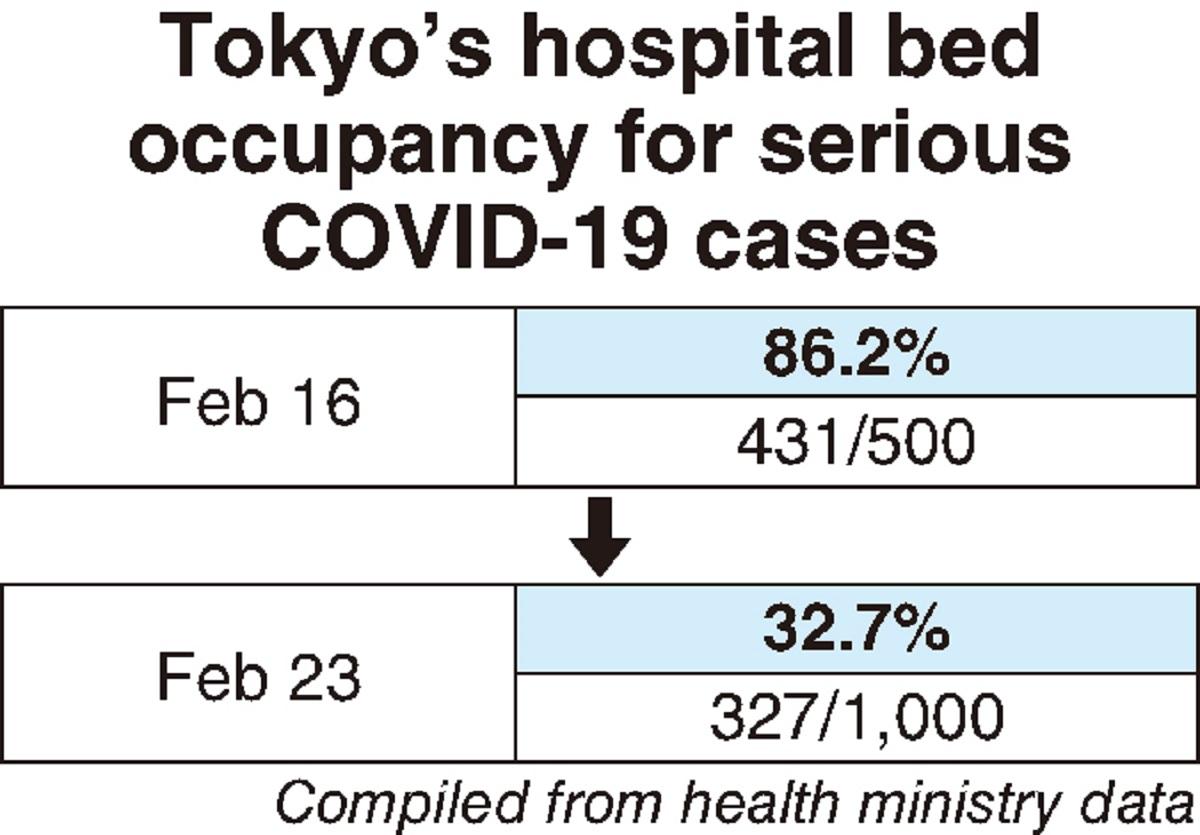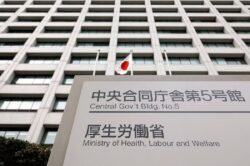
15:03 JST, March 2, 2021
The occupancy rate of hospital beds for seriously ill COVID-19 patients in Tokyo has dropped to 32.7% as of Feb. 23 from the previous week’s 86.2%, according to the weekly figure released by the Health, Labor and Welfare Ministry.
The fall in the rate is mainly because the number of such hospital beds secured in Tokyo increased to 1,000 from 500 when counted under the standards set by the ministry.
Thus, the occupancy rate in Tokyo has dipped into the Stage 3 level of 20% or above from the worst level of Stage 4, which is 50% or above. This will likely have an impact on the ongoing discussions regarding the lifting of the state of emergency in place for Tokyo. The surrounding prefectures of Kanagawa, Chiba and Saitama are also under the state of emergency.
The ministry defines seriously ill COVID-19 patients mainly as those who are admitted to intensive care units (ICU) or advanced care units, and calculates the number of beds for the seriously ill based on the capacity of ICUs and such advanced care units.
On the other hand, the Tokyo metropolitan government had set its own criteria for the seriously ill, who “are considered to be those patients who need ventilators or ECMO.”
The metropolitan government had been reporting to the ministry the number of beds that can handle patients falling into this category only.
However, because Tokyo’s standards differ from those in other prefectures, the ministry in January requested the metropolitan government to adjust them to those set by the ministry.
Subsequently, the metropolitan government checked the number of beds in each medical institution under the ministry’s criteria to confirm in February that there were 1,000 beds available for the severely ill.
On Feb. 16, there were 431 seriously ill patients for 500 beds (86.2%) in Tokyo. Under the new counting method, the occupancy rate on Feb. 23 showed 327 patients for 1,000 beds (32.7%).
“The metropolitan government has now adopted the index that makes the Tokyo situation comparable to the others across the country, so we can discuss it under the same conditions,” said a senior ministry official.
A senior metropolitan government official said: “The number of seriously ill patients has been decreasing, but it is still higher than what we had during the peak of the second wave last summer. The health care system continues to be under strain, and the situation remains unpredictable.”
"Society" POPULAR ARTICLE
-

M4.9 Earthquake Hits Tokyo, Neighboring Prefectures
-

Israeli Tourists Refused Accommodation at Hotel in Japan’s Nagano Pref., Prompting Protest by Israeli Embassy and Probe by Prefecture
-

M7.5 Earthquake Hits Northern Japan; Tsunami Waves Observed in Hokkaido, Aomori and Iwate Prefectures
-

Tsukiji Market Urges Tourists to Avoid Visiting in Year-End
-

M5.7 Earthquake Hits Japan’s Kumamoto Pref., Measuring Upper 5 Intensity, No Tsunami Expected
JN ACCESS RANKING
-

Keidanren Chairman Yoshinobu Tsutsui Visits Kashiwazaki-Kariwa Nuclear Power Plant; Inspects New Emergency Safety System
-

Imports of Rare Earths from China Facing Delays, May Be Caused by Deterioration of Japan-China Relations
-

University of Tokyo Professor Discusses Japanese Economic Security in Interview Ahead of Forum
-

Tokyo Economic Security Forum to Hold Inaugural Meeting Amid Tense Global Environment
-

Japan Pulls out of Vietnam Nuclear Project, Complicating Hanoi’s Power Plans
























